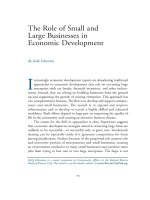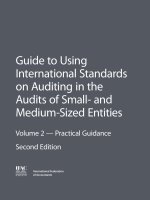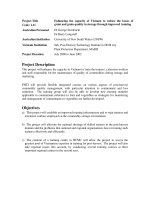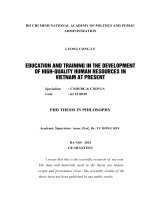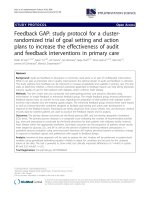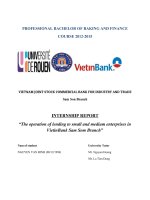Completing tax policies to support the development of small and medium enterprises in vietnam
Bạn đang xem bản rút gọn của tài liệu. Xem và tải ngay bản đầy đủ của tài liệu tại đây (200.99 KB, 12 trang )
INTRODUCTION
1. Necessity of the thesis
support small business development, and improve the investment environment,
is considered as a matter of urgent today in Vietnam.
Small and medium-sized enterprises have an important role in the global
With the above question, the desire to find a way to contribute to
economy. SMEs account for about 96% of businesses worldwide, contributing
complete tax policies to support the development of SMEs, the authors selected
significantly to job creation, economic development, create revenue ... In
topics: "Completing tax policies to support the development of small and
Vietnam, SMEs account for about 97% of the total number of enterprises, using
medium enterprises in Vietnam".
than 50% of workers and create 47% of GDP and contributes about 40% of
2. Research questions
budget revenues. With an important role in the economy, SMEs are always
The research questions posed, to be solved as follows:
interested governments and development assistance. The country was soon
- The elements of tax policy has created tax burden for SMEs like?
developed SME support policies and has been the most successful. Experience
- Status of current tax policy in Vietnam has created the tax burden for
in developed countries shows that SMEs need support on both areas: financial
SMEs like?
and non-financial.
- International experience building and perfecting tax policies to support
Standpoint of corporate benefits, tax policy tax burden for SMEs, the
SMEs and Vietnam how to apply what from that experience?
enterprises with financial resources depends largely on equity. Therefore,
- Vietnam's tax policy is necessary to improve how to support SME
reducing the tax burden is considered to be a key solution to support SME
development?
development. Therefore, tax policy is an important policy in financing solutions
3. Objects and scope of research
for SMEs. The developed nations of the world have been building systems to
Research Subjects
support tax policy effective for SMEs.
On tax policy: the thesis research profile IRS regulations; tax rates
A recent report by the World Bank and global financial institutions (IFC)
applicable to direct taxes and tax regulations in general management;
on the business environment rankings in 2013 showed that the business
including management of direct taxes and indirect taxes are applied to
environment in Vietnam does not have many improvements and further
SMEs
relegation in position 99/189 in the world economy. Private sector pay taxes
Business: object of study is the thesis of SMEs, and divided into two
dropped 11 levels, from rank 138/183 countries, down to 149/189 countries.
groups: SMEs and DNSN because in fact the two groups are now level
Vietnam firms take up to one third of working time in the year, ie 872 hours to
"under" the tax burden is not the same. The two study groups help thesis
comply with tax policy. This greatly affects the operation of enterprises,
has analyzed and proposed more practical.
especially SMEs when many business owners have to both work part-time tax
Limit the scope of the study period: The tax provisions in the period
declaration. So the completion of tax policies for enterprises in general and
2006-2013. Dissertation proposal content and complete solution to
SMEs in particular, from the viewpoint reduce the tax burden, in order to
support tax policies for SME development in 2020.
The scope of the study subjects: research thesis focused two taxes have
Third, the thesis also proposed regulations should be more practical
the greatest impact range and today is the most complex VAT and
incentives for SMEs, which is striking: except now allows 150% of the actual
corporate income tax.
cost of investing in science and technology; tax incentives for business start-up;
4. Contributions of the thesis
The theoretical contributions
First, from a theoretical basis of the tax burden and the results of previous
studies, the thesis clarifies the burden of corporate taxes is constituted by two
reduce the level of VAT.
5. Structure of the thesis
In addition to the preamble and conclusion, the content of the thesis is
divided into four chapters:
factors: the number of direct taxes to be paid and the cost of compliance tax.
Chapter 1: Literature review and research methodology
Thesis indicate the tax burden reduces retained earnings, the financial resources
Chapter 2: Theoretical basis and practical to improve tax policies to
of SMEs is important. Therefore, the improvement of tax policy to support SME
development is an objective requirement.
Second, based on analysis generated two factors of corporate tax burden is
the direct tax payable and tax compliance costs, building thesis research
framework burden of VAT and corporate income tax generated business.
Number of tax payable depends on the taxable income and tax rates. Tax
compliance costs are measured in dollars and time. The provisions of the tax
administration is a major factor generating tax compliance costs.
Contributions in practice
First, tax compliance costs for SMEs at the time of Vietnam is reflected in
the time declare and pay taxes; Pending tax refund, tax claims; service time of
inspection, checking tax. Tax compliance costs reflected cash rent expense
outside tax consultants, pay salaries tax accounting, cost fostering knowledge of
tax and other costs. In the survey results, the thesis shows that SMEs in Vietnam
currently incurs huge cost of tax compliance.
Second, the thesis proposes to use revenue threshold formula VAT
declaration proposed by Keen and Mintz 2004. Accordingly, the revenue
threshold for VAT declaration and reasonable in Vietnam is 400 million VND
instead 100 million VND as current regulations.
support the development of small and medium enterprises
Chapter 3: Status of tax policy to support the development of small
and medium enterprises in Vietnam
Chapter 4: Orientation complete tax policies to support the
development of small and medium enterprises in Vietnam by 2020
CHAPTER 1: LITERATURE REVIEW AND RESEARCH
Pham Van Hong, Nguyen Minh Tuan, Le Thi My Linh, said that SMEs
METHODOLOGY
are also part of the economy now, and moreover should not have large amounts
1.1 Literature review
of text should be legal or law regulating private this group of businesses.
1.1.1 Research on SME development
The concept of SMEs
Pham Van Hong, Tran Thi Van Hoa stated international experience in
defining SMEs through qualitative criteria and quantitative.
Qualitative criteria based on the basic characteristics of SMEs as low
Policies to support SMEs
The authors Pham Van Hong, Nguyen Minh Tuan, Le Thi My Linh, Tran
Thi Van Hoa, have the same opinion that the Government should have policies
to financial and non-financial support to SME development.
1.1.2 Research on tax
specialization, some little clue management, the complexity of managing low ...
Criteria for classification of enterprises in tax administration
The criteria usually include quantitative targets groups: number of regular
In research Ministerial 2011: "Research criteria and classification
workers, the total value of assets (or capital), revenue or profit.
methods to reduce the frequency of corporate tax declaration," Nguyen Quang
Characteristics of SMEs
Tien authors have pointed out the difficulties encountered when using the
First, SMEs have small capital scale, mostly self-owned capital, raised
criteria "number of employees", "total capital" (Decree 56/2009/ND-CP) in tax
from friends and relatives.
Second, small-scale labor, low labor quality.
Third, the main field of activity is the processing sector SMEs,
outsourcing and services.
Fourth, the operator usually SMEs owners, so no high-level management.
administration.
The authors suggest using the criteria "revenue" to classify business rules
applied in the declaration and payment of VAT and SCT.
Orientation perfect tax policy
Oriented studies completed tax policy can mention research "orientation
The need to develop SMEs
completed tax policy after Vietnam joined the World Trade Organization" by
The limitations of SMEs should be supported: the level of technology
Nguyen Phuoc Tien (2010), and research "tax solutions to promote economic
obsolete, old machinery and equipment; restrictions on the size of capital as well
restructuring towards industrialization and modernization in Vietnam "by
as access to formal sources; limited access to information; level of quality
Nguyen Ngoc Tu (2009).
management and labor restrictions.
The view of the development of SMEs
Cost of tax compliance
Cedric Sandford give a definition of tax compliance costs in
According to Tran Thi Van Hoa, SME has its own characteristics, its own
"Administrative and Compliance Costs of Taxation" (1989) as follows: "... the
difficulties, so there should be a policy framework, legal framework, even its
cost of compliance is the cost incurred by the taxpayer or by a third party (eg
own laws to support SMEs.
business partner) in achieving the requirements of the tax system, including the
external costs of the tax obligations of taxpayers and in addition to the costs that
the tax system has rules ... ".
Factors affecting tax compliance costs
Second, analysis of complete factual basis for the SME tax policy of
Vietnam today, including international research experience and analysis of the
current state tax policy in Vietnam.
Das-Gupta (2003) studied the cost of tax compliance in India in "The
Third, the proposal of completing a thesis on tax policy to support SME
Income Tax Compliance Costs of Corporations in India, 2000-2001"; La Xuan
development. On the basis of complete perspective, the thesis proposes solutions
Dao (2009) is one of Vietnam's first human study of tax compliance costs in the
content and complete tax policy to support SME development in Vietnam in the
topic "Analyzing the impact of compliance costs for taxpayers in the Mekong
coming time.
Delta."
1.2 Research Methodology
A study by Business New Zealand-KPMG (2003) survey "First
Thesis using statistical methods, comparison, analysis, case studies
Compliance Cost Survey" also indicates the factors affecting tax compliance
combined with survey methods. Methods of analysis, synthesis used in research
costs in New Zealand.
documents, legal documents about the tax. Statistical methods are used to
1.1.3 Evaluation of previous research
analyze the number of primary and secondary data obtained through the survey
First, the unsystematic component elements of tax policy to create the tax
burden for SMEs.
Second, no assessment of the current state tax policy in Vietnam has
created the tax burden for SMEs like?
Third, the system has not been international experience in the construction
and completion of tax policy to support SMEs to draw the lessons learned can be
applied in Vietnam.
Fourth, not provide perspective and specific content-oriented tax policy in
order completed support SME development in Vietnam with the aim of reducing
the tax burden for businesses.
1.1.4 The objective of research
First, determine the theoretical basis of complete tax policies to support
the development of SMEs in Vietnam, including: forming the basis of tax policy
for SMEs; the elements of the tax burden from the provisions of tax policy for
SMEs;
method. Primary data obtained through the survey is used to assess the status of
the tax burden on SMEs.
TO
100 billion VND medium enterprises; business group has sales of less than 50
IMPROVEMENT TAX POLICIES TO SUPPORT THE DEVELOPMENT
billion VND small business and individual business households in groups of
OF SMALL AND MEDIUM SMALL ENTERPRISES
micro enterprises. Therefore, the object of study of the thesis is SMEs have an
2.1 Tax theory and support the development of small and medium
annual turnover not exceeding 100 billion VND.
enterprises
2.1.3 The view of tax policy to support the development of small and medium
2.1.1 The basic theory of taxation and tax policy
enterprises
CHAPTER
2:
THEORETICAL
BASIS
AND
PRACTICE
Taxes are compulsory contributions to organizations and individuals to
form the state budget.
Balance between the interests of state and corporate interests: To nurture
revenues, tax policy can not create undue burdens for businesses. However, the
Tax policy is overall attitudes, policies and solutions are specified by the
formulation of tax policy has its own rules and incentives for SMEs will affect
system prescribed in legal documents on taxation, is used as a basis for the
certain revenues to the state budget. Therefore, when constructing tax policy to
implementation of State management activities tax.
support SME development need to ensure a balance between state interests and
Completing tax policy is the proposed amendment, supplement new rules
for each specific taxes and for tax administration in general, in order to meet the
requirements and objectives.
Each type of tax is made up of a number of factors, namely: name;
Taxpayers; Subjects taxable tax base; Tax rates and other factors.
corporate interests.
Towards effective social tax policy is just one of the tools and solutions to
support SME development. So when developing tax policy to support SME
development should be considered in the perspective of overall social benefit.
Towards long-term benefits: Although the tax incentives for SMEs can
Sort by regulating properties, shall be divided into two categories: direct
reduce tax revenues in the short term but building tax policies to support the
taxes and indirect taxes. Direct taxes directly create burdens for taxpayers.
development of SMEs will increase the tax base in the long term, thus ensuring
Indirect tax burden created indirectly through business tax compliance costs.
revenue in the long term.
Taxes have three main roles: as a tool to mobilize financial resources for
the State; is an effective tool of redistribution policies guaranteed income social
justice; is a tool to regulate the macro economy.
Effective tax system to achieve the following requirements: economic
2.2 Theory and practice of the tax burden on small and medium enterprises
2.2.1 Tax Burden
The burden of corporate taxes is understood that all expenses that
businesses must spend on tax obligations. Thus, the tax burden would include
efficiency; fairness; simplicity; flexibility.
the amount of tax payable under the provisions and other costs related to
2.1.2 The concept of small and medium enterprises in tax policy
implementation of tax obligations.
In view of the thesis, all subjects production business is subject to tax
administration are considered now. Thesis criteria used to define SMEs revenue.
Thesis divided business groups as follows: group business revenue from 50 to
Tax Burden = direct tax amount payable + tax compliance costs
2.2.2 Cost of tax compliance
By Cedric Sanford (1989), "compliance costs are the costs incurred by the
2.3.2 Methodology of the thesis
taxpayer or by a third party (eg, business partners) in achieving the requirements
The thesis will carry out surveys to describe the tax burden of SMEs. By
of the tax system, including the external costs of the tax obligations of taxpayers
allowing businesses assess the income tax provisions and the current VAT,
and beyond the cost of the tax system that has defined ".
combined with descriptive statistical methods, the thesis will assess the tax
Factors affecting tax compliance costs: the complexity of the tax
burden of SMEs.
provisions; frequency declare and pay tax in the year; tax administrative
2.4 International experience building tax system to support small and
procedures; method declaration and payment; charged more taxes on the same
medium enterprises
Following are experienced tax policy to support the development of SMEs
tax base; procedures for settling complaints and refund.
2.2.3 The need to complete tax policies to support the development of small
in a number of OECD countries.
and medium enterprises
2.4.1 The regulations reduce the burden of supporting the cost of compliance
The results of the empirical research has shown that the reason for the
need to develop policies to support SME development tax include: high tax
burden; The burden of compliance costs regressive scale enterprises; High tax
burden will affect SMEs by reducing retained earnings and create incentives for
- Build the VAT threshold will reduce the number of SMEs must declare
and pay taxes.
- Revenue registration threshold to declare and pay VAT in accordance
with simple methods.
- To offset the burden of high tax compliance costs by preferential VAT
tax evasion.
2.3 Analytical framework and implementation methodology of the thesis
rate calculated by simple methods.
- Reduced multiple tax rates: only maintain two tax rates.
2.3.1 Analytical Framework
- Reduced frequency of tax declaration.
Tax policy
(+)
Tax base
Tax
rates
Regulations
on tax
administratio
n
direct taxes and indirect, but only have to pay a presumptive tax. Two
(-)
(+)
CIT
VAT
- Construction of presumptive tax system: the DNSN not have to pay more
CIT
payable
The tax burden
(+)
presumptive tax system is the most popular and presumptive tax under
Retained
earnings
of SMEs
presumptive tax revenue based on the characteristics of the business.
2.4.2 The provisions reduce the tax burden on business income
Cost of tax
compliance
- CIT tax incentives.
- Incentives for new businesses established: reduce the corporate income
tax rate for newly established businesses.
- Support research and development: SMEs have been allowed unless an
CHAPTER 3: THE STATE TAX POLICY TO SUPPORT THE
expense greater than the actual cost of investing in research and
DEVELOPMENT OF SMALL AND MEDIUM ENTERPRISES IN
development at CIT payment.
VIETNAM
- Encouraging SME investment.
3.1 Background and socio-economic reality of small and medium
- Allow depreciation simple.
enterprises in Vietnam
2.4.3 The content can be applied in Vietnam
- Build the VAT threshold.
- Incentives for business bookkeeping records declaring the VAT by simple
methods.
- Reduced multiple tax rates: only maintain two tax rates.
- CIT Incentives for SMEs.
3.1.1 Economic Context - social period 2001-2012
Continuous economic growth with decent speed, average 6.96%. Growth
target of 5-year plan of economic development and social 2001-2005; 20062010 respectively 7.51% and 7.01% / year. National income per capita has
increased fairly steadily, averaging 5.7%.
By 2012, Vietnam has 44 million people participated in the labor force,
- CIT incentives for newly established SMEs.
equivalent to 51.1% of the population. Private sector created the most jobs
- Allow accelerated depreciation for assets as equipment and machinery for
(more than 87% of total employment) but only 28% of the total social
the manufacture directly.
- Construction of presumptive tax system.
investment.
3.1.2 Status of Small and Medium Enterprises in 2001-2012
In 2001-2005
SME sector in the 2001-2005 period there has been a drastic increase in
number. From 2001 to 2005, there were over 150,000 enterprises registered
establishment with registered capital of more than 311 trillion VND.
In 2006-2012
Overall for the period 2006-2012, the total number of newly-established
enterprises reached about 431052 businesses, including some newly established
SME business is about 422430 the total number of registered enterprises
established far more than 670,000 business now with registered capital of more
than 4,520 trillion VND(approximately $ 218 billion).
Besides, SMEs also contribute significantly to the total revenue. In 2010,
SMEs contributed 42.5% of total domestic revenue, contribute significantly to
the development of the country.
3.2 Status of tax policy to support small and medium enterprises in
Tax support for investment projects in areas with difficult socio-economic
Vietnam
difficulties, economic zones and high-tech zones.
3.2.1 Status of tax policy to support general business
3.2.2 Status of tax policy support for small and medium businesses
3.2.1.1 The support to reduce tax compliance costs
3.2.2.1 These regulations support reducing tax compliance costs
With the aim of reducing the burden of compliance costs for businesses
These regulations support reduces compliance costs include the revenue
when making their tax obligations , tax policy in Vietnam now has more
threshold specified VAT declaration; method applies a simple calculation of
regulations in order to create favorable conditions for businesses include:
VAT; reducing the incidence of VAT declaration and apply the presumptive tax
Supporting information: businesses will be supported, guiding the
implementation of the payment and provision of information and documents to
fulfill the obligation, the tax benefits .
Lodge complaints and denunciations: businesses have the right to
compensation by the tax administration , tax administration and public causes as
prescribed by law.
Support for self- printing, issuing bills: the associations of individual and
business tax codes are allowed in order to register and issue invoices.
Support the declaration and payment of tax: Tax Management Act
regime. Specifically as follows:
First, the regulation threshold to declare VAT revenue is 100 million /
year for DNSN.
Second, the revenue threshold specified register, declare and pay VAT
under the deduction method is 1 billion VND/year.
Third, the method applies a simple calculation of VAT.
Fourth, reducing the frequency declared: Enterprises with an annual
turnover of 20 billion or less are declared and paid quarterly VAT.
Fifth, presumptive tax regime applied by revenue in lieu of indirect taxes,
regulations allow businesses to make the declaration and payment of taxes
such as VAT and special consumption tax, resources tax.
through electronic means.
3.2.2.2 Regulations to support reducing CIT burden
Support for tax registration: implementing the OSS licensing business
registration and tax registration numbers.
Supports full deduction of input VAT as a fixed asset purchases.
Support businesses involved with regulation of export tax rate of 0%.
3.2.1.2 The support to reduce the CIT
The support tax burden is shown in the supporting regulations as reducing
the tax base and reduce tax support.
Now has a total annual turnover not exceeding 20 billion tax paid at the
rate of 20% (compared to the general tax rate of 22% applies to all 2015).
3.2.2.3 Evaluation of business for a specified number of support
In support of the activities of the business tax, regulation and electronic
tax declaration allows businesses to print invoices business community
welcomed scores 4.48 and 4.45.
The other supporting activities: support procedures to declare and pay
Supports reducing the tax base include provisions on tax-exempt income;
taxes; tax refund; resolving complaints; accelerated depreciation provisions of
amounts are appropriated from the income before tax and depreciation, loss
the declaration were rated below average scores respectively: 2.63; 2.58 and
carry forward.
2.46 with 30% less satisfied comments.
3.2.3 Evaluation tax policy to support small and medium enterprises
3.2.3.1 The encouraging results
First, businesses are creating favorable conditions to access the latest
information.
Second, business rules allow tax declaration and tax payment by
electronic transfer methods are the business community are welcome.
Through in-depth interviews with staff tax accountant and tax consultant
staff, the thesis shows that business activities must be carried out to implement
the tax liability and a number of factors affecting tax compliance costs, served
for the design of the questionnaire.
On the basis of information obtained from in-depth interviews, thesis
design two types of questionnaires: enterprise (legal status) and individual
Third, the turnover threshold was launched to identify SMEs.
business households (DNSN). Questionnaires were sent and start collecting from
Fourth, the construction method of VAT calculation simple.
01/03/2013 until 05/14/2013. Total receipts of respectively 394 and 146 votes.
Fifth, CIT Law has supported many regulations on business income tax
Of the 394 enterprises, 58 enterprises have an average annual turnover of more
exemption and preferential income tax rate.
Sixth, regulations set up funds for science and technology policy reflects
the correct orientation of the government to encourage the development of
science and technology, thus contributing to reduce the tax burden.
3.2.3.2 The limitations to be overcome
First, even otherwise specified threshold to declare VAT revenue is 100
million VND/year but this threshold is not really reasonable.
Second, the presumptive tax regime is not completely reduce tax
compliance costs for businesses as presumptive tax not included PIT.
Third, reimbursement support and resolve tax claims not create
satisfaction for the business community.
Fourth, the provisions on tax exemption, tax incentives have not really
made clear to the EIT Law became complicated.
Fifth, rules set up funds for science and technology has not really set up
funds for SMEs encouraged.
3.3 Status of the burden of tax compliance costs of small and medium
than 50 billion VND.
3.3.2 Conclusion on the status of the tax burden of small and medium
enterprises
First: Every year businesses more time to implement tax obligations. The
average time to perform regular activities include: time to declare VAT,
corporate income tax return time and time collection , storage bills and vouchers
of 247 hours/year;
Second: In addition to the cost of time, businesses also have to pay cash to
carry out their tax obligations.
Third: "Time collection bills, vouchers" is now considered the largest
contribution in the cost structure of the business tax compliance .
Fourth: "frequency declaration" is said to have greatly influenced the
VAT declaration time.
Fifth: "The amount of information must be provided" has the second
largest impact to time declare VAT.
Sixth: Meanwhile "tax rate" and "accounting regime complex" and
enterprises in Vietnam
"specified tax incentives unclear" for the three biggest factors creating tax
3.3.1 Description of the research steps
burden.
Seventh: propaganda support for microenterprises tax has many
limitations and inefficient operations.
Eighth: 100% microenterprises be asked to pay VAT under the
presumptive tax methods.
Ninth: There were 60.2% microenterprises that more tax is payable, thus
increasing the cost of tax compliance.
CHAPTER 4: ORIENTATION COMPLETE TAX POLICIES TO
SUPPORT
THE
DEVELOPMENT
OF
SMALL
BUSINESS
DEVELOPMENT IN VIETNAM BY 2020
4.1 Pursuant to complete tax policies to support the development of small
and medium enterprises in Vietnam
Complete tax policy direction to support SME development thesis built
on the basis of the policy of the State in tax policy and SME development,
including strategic tax reform plan SME development and policy support SME
development.
4.2 Orientation complete tax policies to support the development of small
and medium enterprises in Vietnam by 2020
4.2.1 The view of the complete dissertation on tax policy to support the
development of small and medium enterprises
First, SMEs classified into groups, there are specific regulations on tax,
applied to each target group of SMEs.
Second, the contents must be completed towards the simplicity of the tax
system.
Third, tax policy must be completed in accordance with management
skills and reduce tax administration costs.
Fourth, ensure budget revenue.
Fifth, ensure fairness.
Sixth, should create incentives for SME steps involved in the tax system
standards.
4.2.2 Orientation complete tax policies to support the development of small
and medium enterprises
For VAT
First, build the threshold for declaration and payment of VAT: proposed
thesis uses the revenue model of threshold proposed by Keen and Mintz 2004.
Accordingly, the argument proposed raising income thresholds for declaration
and payment of VAT from 100 million to 400 million.
Second, the turnover threshold for VAT declaration and deduction
method: Proposed raised 2 billion.
Third, reduce the tax rate: 2 types of tax regulations: 0% and 10%.
Fourth, lose declare VAT on the business activities of goods and services
not subject to VAT.
Fifth, building presumptive tax including personal income tax.
Sixth, separate building for the exchange of tax DNSN services such as
restaurants, hotels, karaoke, bars, massage.
Solutions related to the management and human resources solutions
including: Complete process and settle claims reimbursement; Streamlining
management apparatus, enhance management efficiency.
4.2.4 Recommendations to the Government
First, more boldly in the use of tax policy as a tool to support the
development of SMEs.
For VAT: Putting rules on turnover threshold for VAT exemption, a tax
rate of VAT in the VAT Act.
For corporate income tax: Give preferential tariff regulations; encourage
businesses to invest in research and development of science - technology in law.
FOR CIT
Regulations now allow accelerated depreciation and incentives for new business
First, the tax rate is progressive with two levels of tax: income tax from 0
establishment should be included in the Decree.
to 5 billion VND tax rate of 20%; 5 billion VND on a 22% tax rate.
Second, the tax exemption for newly established SMEs have revenue less
than 50 billion in the first year of establishment.
Third, the regulations allow businesses to be 150% minus the actual cost
of investment in research and development of science and technology before
income tax calculation.
Fourth, accelerated depreciation allow SMEs. Regulations, allowing
SMEs 50% for depreciation of machinery and equipment;
Fifth, taxable building regulations based on cash accounting system.
4.2.3 Solutions implement
Group communication solutions, including business support solutions to
provide information, support solve problems related to procedures for
declaration and payment of tax.
Team building solutions manage information systems and electronic
portal.
Second, the Government should soon complete management information
systems and e-government projects.
CONCLUSION
First, the object of the dissertation research focused on two types of taxes
have the greatest scope for the enterprise income tax and VAT.
Tax policy, considering the perspective of corporate interests, create the
tax burden for businesses. The burden of corporate taxes is reflected in the
number of direct tax payable and tax compliance costs. Number of direct tax
payable depends two factors: the tax rate and tax base. The provisions of the
Second, the sample SMEs have not really popular. SMEs surveyed are
selected on two major cities, Hanoi and Ho Chi Minh City.
Third, the thesis is not to evaluate the specific impact of the application of
the tax structure progressive in tax revenues to the budget.
declaration, tax payment, tax administration burden created tax compliance costs
These restrictions are due to a number of main reasons, namely:
for businesses. Tax compliance costs create huge burden for SMEs than large
First, the limited research budget should affect the size of the sample and
enterprises. Therefore, compliance costs have important implications in the
development of SME programs in the country.
System of Vietnam's tax policy today despite many provisions for tax
incentives to encourage business investment and development. However, such
the sample of SMEs to investigate.
Second, tax policy changes so frequently secondary data is not reliable
enough to build econometric models to assess the impact of changes to corporate
tax revenues as budget can not.
incentives are not really aimed at supporting SME development. So to support
The restrictions above will be the "gaps" need to continue research aimed at
SMEs, Vietnam's tax policy should have provisions specific tax incentives for
perfecting tax policies contribute to the development of SMEs but also meet the
SME group.
requirements of the tax administration in the future.
With this status , the thesis proposes a complete orientation to support tax
policy for SMEs, such as construction revenue threshold, apply a simple method
for calculating tax, corporate tax incentives to encourage SMEs investment in
research and development of science and technology. In particular it is important
to build revenue -free threshold to declare and pay VAT have a scientific basis.
However, in order to better support for SMEs, there should be close
coordination between state management agencies at all levels in the propagation
and taxpayer support. Helping taxpayers understand their responsibilities and
rights as taxpayers. There is so effective management of new state tax increase,
thereby raising the efficiency of revenue collection, to assist the Government
implement the conditional SME support programs other better.
However, in general, the thesis still some limitations:

